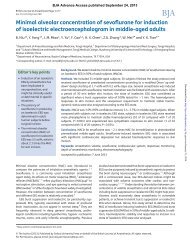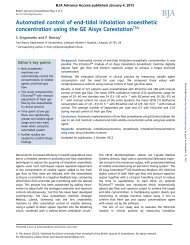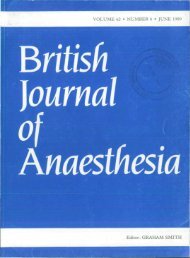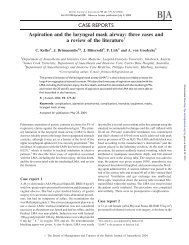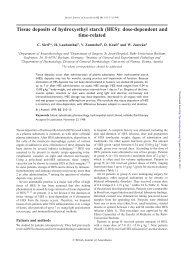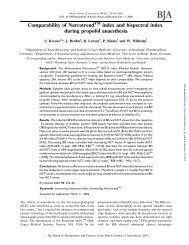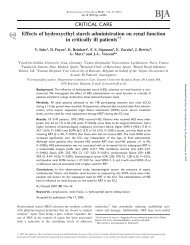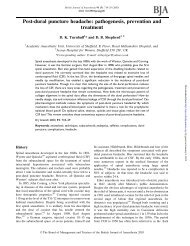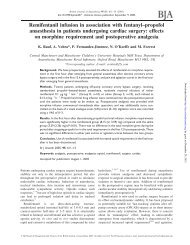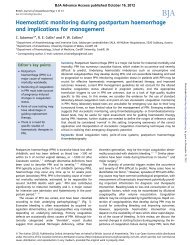Postoperative pain after abdominal hysterectomy: a ... - BJA
Postoperative pain after abdominal hysterectomy: a ... - BJA
Postoperative pain after abdominal hysterectomy: a ... - BJA
You also want an ePaper? Increase the reach of your titles
YUMPU automatically turns print PDFs into web optimized ePapers that Google loves.
<strong>BJA</strong><br />
Perniola et al.<br />
administration of LA during neuraxial or peripheral nerve block<br />
gives better postoperative analgesia compared with continuous<br />
infusions. 13 – 17 Therefore, we decided to test the hypothesis<br />
that patient-controlled i.p. analgesia (PCipA) with LA<br />
would reduce <strong>pain</strong> intensity and thereby supplemental opioid<br />
consumption compared with continuous infusion of LA.<br />
The primary aim was therefore to analyse rescue analgesic<br />
consumption during 0–24 h <strong>after</strong> operation <strong>after</strong> <strong>abdominal</strong><br />
<strong>hysterectomy</strong> in patients receiving continuous LA infusion<br />
compared with intermittent patient-controlled i.p. injections.<br />
The secondary outcomes were analgesic consumption during<br />
0–4 h, <strong>pain</strong> intensity, incidence of nausea and vomiting,<br />
maximum expiratory pressure, time to mobilization, and<br />
length of hospital stay, and also health-related quality of life<br />
at 1 and 3 months.<br />
Methods<br />
This study was registered in an international registry, clinicaltrials.gov<br />
(identification number NCT01492075) before<br />
patient recruitment. The study was performed at the Department<br />
of Anaesthesiology and Intensive Care and the Department<br />
of Gynaecological Surgery, University Hospital, Örebro,<br />
Sweden, and monitored by an external organization not<br />
involved in any way with the study. This unit is a quality-based<br />
organization located within the hospital and initiates and<br />
monitors clinical trials. After approval from the Regional<br />
Ethics Committee, Uppsala, oral and written informed<br />
consent was obtained from 40 patients (ASA status I–II),<br />
aged 40–65 yr undergoing elective <strong>abdominal</strong> <strong>hysterectomy</strong><br />
with or without salpingo-oophorectomy in this randomized,<br />
double-blind study. The exclusion criteriawere: patients undergoing<br />
surgery for suspected gynaecological cancer, patients on<br />
chronic analgesic medication, those with known allergy to LA,<br />
patients participating in another clinical study, and those who<br />
had difficulty in understanding Swedish.<br />
Randomization and blinding<br />
On the day of surgery, the Hospital Pharmacy randomized<br />
patients into two groups (20 in each group) using computergenerated<br />
randomized numbers inserted into sealed opaque<br />
envelopes and marked 1–40. All personnel involved in<br />
patient management were fully blinded to the method of analgesia<br />
until the study was completed.<br />
Anaesthesia and surgery<br />
All patients were premedicated with midazolam 0.1 mg kg 21<br />
orally and paracetamol 1 g was given orally every 6 h with<br />
the first dose at the time of premedication. Anaesthesia was<br />
induced with fentanyl 1–2 mg kg 21 and propofol 1–2 mg<br />
kg 21 intravenously. Tracheal intubation was performed <strong>after</strong><br />
muscle relaxation with rocuronium 0.5 mg kg 21 and anaesthesia<br />
was subsequently maintained with sevoflurane 1–3% and<br />
oxygen 33% in air. End-tidal CO 2 was maintained between 4.5<br />
and 5.5 kPa using mechanical ventilation in a low-flow breathing<br />
system with CO 2 absorber. Monitoring included non-invasive<br />
arterial pressure, heart rate, peripheral oxygen saturation,<br />
Page 2 of 9<br />
end-tidal gas monitoring, ECG, and muscle relaxation using<br />
the train-of-four stimulation. Sevoflurane concentration was<br />
adjusted in order to maintain adequate anaesthetic depth,<br />
assessed clinically, and fentanyl was given intermittently intravenously<br />
when required for analgesia during the operation.<br />
Muscle relaxation was reversed at the end of surgery using glycopyrrolate<br />
(0.5 mg) and neostigmine (2.5 mg). Hysterectomy<br />
was performed using either a lower-<strong>abdominal</strong> midline incision<br />
or a Pfannenstiel incision, depending on the choice of<br />
the operator taking into consideration the size of the uterus<br />
and expected surgical difficulty.<br />
Catheter insertion and postoperative <strong>pain</strong><br />
management<br />
Before closing the peritoneum, two multi-hole catheters were<br />
inserted percutaneously by the surgeon; one catheter was tunnelled<br />
from the left side and the other from the right side, about<br />
1–2 cm lateral to the <strong>abdominal</strong> incision and the tip of the<br />
catheters was placed supravaginally as described previously. 2<br />
The catheters were not fixed intraperitoneally. In all patients,<br />
levobupivacaine 1.25 mg ml 21 (20 ml) was injected subcutaneously<br />
along both sides of the incision before skin closure by the<br />
surgeon; an additional 20 ml was injected via one of the cathetersintothe<br />
peritoneal cavity. The pharmacysent (i) oneblinded<br />
bag, containing 500 ml of levobupivacaine 1.25 mg ml 21 or<br />
placebo (normal saline) and (ii) one elastomeric pump (On-Q<br />
Pain BusterR, ref PS125071; I-Flow Corp., Lake Forest, CA, USA)<br />
containing 500 ml of levobupivacaine 1.25 mg ml 21 or placebo<br />
(normalsaline).Whenthepatientarrivedinthepost-anaesthesia<br />
care unit (PACU), the infusions were set up, connected, and<br />
started by one of the co-authors immediately as described<br />
below. The time of start of infusion was considered t¼0.<br />
Group P: PCipAwith LA. The patients self-administered 10 ml<br />
of levobupivacaine via the first i.p catheter as required<br />
(maximum once per hour) during the first 48 h <strong>after</strong> the<br />
operation via an electronic pump (Abbot GemStar, Abbot<br />
Laboratories, North Chicago, IL, USA) over 10 min. Normal<br />
saline was infused at 10 ml h 21 via the second i.p catheter<br />
using the elastomeric pump.<br />
Group C: continuous i.p. infusion of LA. Patients received a<br />
continuous infusion of levobupivacaine 10 ml h 21 intraperitoneally<br />
through the first catheter via the elastomeric pump<br />
and saline as bolus injection via the second i.p. catheter<br />
using the electronic pump. After 48 h, the i.p. bolus/infusion<br />
was stopped and both catheters were removed.<br />
Rescue medication and postoperative ward<br />
All patients received 2–4 mg ketobemidone intravenously, an<br />
opioid analgesic equipotent with morphine, 18 intermittently<br />
by the staff nurse if <strong>pain</strong> was .3 on the numerical rating<br />
scale (NRS) (0, no <strong>pain</strong>; 10, worst imaginable <strong>pain</strong>). Analgesics<br />
were administered on patient request, irrespective of whether<br />
the <strong>pain</strong> was .3 at rest, on sitting, or during coughing. The<br />
patients were observed in the PACU until the day <strong>after</strong> the<br />
surgery. In the case of severe postoperative nausea or vomiting<br />
(PONV) not relieved by anti-emetics, the nursing staff were<br />
Downloaded from http://bja.oxfordjournals.org/ by guest on January 17, 2014



